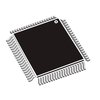-
Part Symbol
-
Footprint
Available Download Formats
By downloading CAD models, you agree to our Terms & Conditions and Privacy Policy

RISC MICROCONTROLLER
Tip: Data for a part may vary between manufacturers. You can filter for manufacturers on the top of the page next to the part image and part number.
LPC1549JBD64 by NXP Semiconductors is a Microcontroller.
Microcontrollers are under the broader part category of Microcontrollers and Processors.
Microcontrollers (MCUs) are small, low-power integrated circuits used to control embedded systems. Microcontrollers are primarily used to automate and control devices. Read more about Microcontrollers and Processors on our Microcontrollers and Processors part category page.
By downloading CAD models, you agree to our Terms & Conditions and Privacy Policy
|
|
LPC1549JBD64
NXP Semiconductors
Buy Now
Datasheet
|
Compare Parts:
LPC1549JBD64
NXP Semiconductors
RISC MICROCONTROLLER
|
| Rohs Code | Yes | |
| Part Life Cycle Code | Active | |
| Ihs Manufacturer | NXP SEMICONDUCTORS | |
| Package Description | LQFP64 | |
| Reach Compliance Code | compliant | |
| ECCN Code | 3A991.A.2 | |
| HTS Code | 8542.31.00.01 | |
| Samacsys Manufacturer | NXP | |
| Has ADC | YES | |
| Address Bus Width | ||
| Bit Size | 32 | |
| Clock Frequency-Max | 25 MHz | |
| DAC Channels | YES | |
| DMA Channels | YES | |
| External Data Bus Width | ||
| JESD-30 Code | S-PQFP-G64 | |
| JESD-609 Code | e3 | |
| Length | 10 mm | |
| Moisture Sensitivity Level | 1 | |
| Number of I/O Lines | 44 | |
| Number of Terminals | 64 | |
| On Chip Program ROM Width | 8 | |
| Operating Temperature-Max | 105 °C | |
| Operating Temperature-Min | -40 °C | |
| PWM Channels | YES | |
| Package Body Material | PLASTIC/EPOXY | |
| Package Code | LFQFP | |
| Package Shape | SQUARE | |
| Package Style | FLATPACK, LOW PROFILE, FINE PITCH | |
| Peak Reflow Temperature (Cel) | 260 | |
| RAM (bytes) | 36864 | |
| ROM (words) | 262144 | |
| ROM Programmability | FLASH | |
| Seated Height-Max | 1.6 mm | |
| Speed | 72 MHz | |
| Supply Voltage-Max | 3.6 V | |
| Supply Voltage-Min | 3.3 V | |
| Supply Voltage-Nom | 3.3 V | |
| Surface Mount | YES | |
| Technology | CMOS | |
| Temperature Grade | INDUSTRIAL | |
| Terminal Finish | TIN | |
| Terminal Form | GULL WING | |
| Terminal Pitch | 0.5 mm | |
| Terminal Position | QUAD | |
| Time@Peak Reflow Temperature-Max (s) | 30 | |
| Width | 10 mm | |
| uPs/uCs/Peripheral ICs Type | MICROCONTROLLER, RISC |
This table gives cross-reference parts and alternative options found for LPC1549JBD64. The Form Fit Function (FFF) tab will give you the options that are more likely to serve as direct pin-to-pin alternates or drop-in parts. The Functional Equivalents tab will give you options that are likely to match the same function of LPC1549JBD64, but it may not fit your design. Always verify details of parts you are evaluating, as these parts are offered as suggestions for what you are looking for and are not guaranteed.
| Part Number | Manufacturer | Composite Price | Description | Compare |
|---|---|---|---|---|
| LPC1549JBD64,151 | NXP Semiconductors | Check for Price | RISC Microcontroller, 32-Bit, FLASH, CMOS, PQFP64 | LPC1549JBD64 vs LPC1549JBD64,151 |
The internal oscillator can be configured to run up to 12 MHz, but the maximum clock frequency depends on the specific configuration and the voltage supply. Typically, it can run up to 8 MHz with a 3.3V supply.
To configure the USB interface in device mode, you need to set the USB_MODE pin high, enable the USB clock, and configure the USB registers (e.g., USB_DEV_CTRL, USB_EP_CTRL) according to the USB specification. You may also need to implement a USB device stack in your firmware.
Yes, the ADC can be used in sleep mode, but it requires some additional configuration. You need to enable the ADC clock, configure the ADC registers, and use the ADC's low-power mode. Additionally, you may need to wake up the MCU periodically to process the ADC conversions.
To implement a bootloader that can update the firmware over UART, you need to create a bootloader that can receive and process UART data, store the received data in flash memory, and update the firmware accordingly. You may need to use a UART library and a flash programming library in your firmware.
The maximum current that can be sourced or sunk by the GPIO pins is typically around 4-6 mA, depending on the specific pin and the voltage supply. However, it's recommended to check the datasheet and the specific application notes for more detailed information.